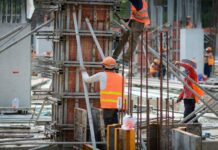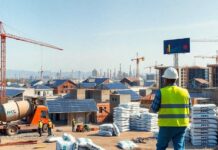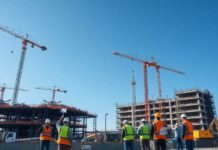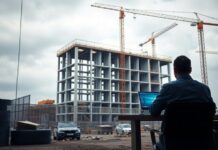Construction activity in Saudi Arabia remains sluggish, with only a marginal pick-up expected in 2018 following two years of contraction. The recovery will gain momentum in the following years, assuming that oil prices edge up and that political risks in the region do not greatly disrupt investment flows.
Construction output is estimated to have fallen by 2% in real terms in 2017, an outturn that reflects a reduction in government spending, the continued low price levels for oil, ongoing headwinds in the private construction market, and a slowdown in broader economic activity in the country. In the first quarter of 2017, construction output (as measured by gross value added) had dropped by 3.2% year on year.
Although the government plans to prioritise some projects and scale down others, and oil prices are likely to recover somewhat over the course of 2018, this is unlikely to provide much upward relief to the sector as the fundamental picture remains bleak and market headwinds persist. Accordingly we forecast real growth of just 1% in 2018.
Real construction output fell by 3.3% in 2016 on the back of a broader economic decline in the country. Economic growth slowed to 1.4% in 2016, far below the average of 4% average growth rate achieved over the past decade, on the back of low oil prices combined with austerity measures weighing on consumer confidence and prompting business to delay investment decisions. In order to reign in the budget deficit, the government slashed spending on infrastructure, keeping its spending below its original budget projection in 2016; actual total spending over the year was SAR825bn, compared with expected SAR840bn.
In its 2017 budget plan, the government announced that it would increase total spending to SAR890bn, from the SAR840bn previously expected for the year, with a substantial increase in infrastructure spending.
Economic data suggests that GDP in Q1 2017 (the latest data available at the time of writing) registered a 0.5% contraction compared to Q1 2016. However, non-oil economic activity increased by around 0.7% over this period. Although official GDP data for later in 2017 has not yet been released, other indicators point to subdued economic activity, in line with Timetric’s expectations for the country.
In Q2 2017, Saudi Arabia’s budget deficit fell to SAR46.5bn as income from oil climbed. Total revenue increased 6 % in Q2 to SAR163.9bn after income from crude jumped 28% compared to Q2 2016. That helped narrow the deficit, despite a fall in revenue from non-oil sources of 17% over Q2 2016. Spending declined 1.3%. The government aims to achieve fiscal balance and eliminate the yearly budget deficit by 2020 by increasingly moving away from oil and developing other sectors of the economy.
Following the announcement from the Ministry of Finance (MOF) that it will cut infrastructure expenditure by nearly 60% in 2016, dropping from SAR63 billion in 2015 to SAR23.9 billion in 2016, Timetric expected the lion’s share of growth in new contracts to come from the private sector. This played out over the year, and we expect this to be increasingly the case in the coming years. However, the private sector faced headwinds.
Indeed, private contractors face increased difficulties on the back of a slowdown in government spending, delays in project timelines, rising borrowing costs, and slow contract payments. The Saudi Interbank Offered Rate, Saibor, nearly tripled over the course of 2016, resulting in a tightening of liquidity across the market, particularly for sectors with generally highly leveraged companies, such as construction companies. The rate has dropped from the 2016-highs, but remains elevated compared to 2015-levels.
Many projects across the country, particularly for large public transport infrastructure projects and commercial developments, stalled in 2016, although investment in oil and gas projects largely continued, as well as in power sector, primarily because of the award of a few large contracts. This is due to the country’s ongoing push to diversify its economy away from oil as part of Vision 2030, and we expect the oil and gas and power sectors to continue to outperform the broader construction market over the duration of the forecast period to 2022.
Oil prices are expected to pick up in 2018, and this will provide some respite to Saudi Arabia’s balance of payments and government revenue outlook. This has partly informed our slightly more bullish market outlook for 2018.
Headwinds for private construction market
Due to the deterioration in construction activity across the country since 2016, competition in the market has increased, and builders are operating on lower margins in order to obtain the remaining available business. Consequently, profits for construction companies have generally deteriorated further over the course of 2017.
For the construction industry, banks are the primary sources of financing. Banks had historically operated a very open loan policy strategy, but in 2016 and 2017 lending declined due to the broader deterioration in the economy, higher interest rates, and increasing default rates. This, combined with reduced demand, has strained the cash flow position of most construction businesses, particularly smaller players.
As the market situation improves over the course of 2018, we expect to see an improvement in the operating conditions for companies. Nevertheless, payment delays and defaults are likely to continue over the coming year.
Saudi Arabia’s Crown Prince, Mohammed bin Salman, has undertaken sweeping reforms across the country in a bid to diversify the economy away from oil and better integrate the private sector, particularly focusing on attracting foreign investment. Part of such reforms has been a crackdown on corruption, with a number of high-profile political and business figures arrested. Over the long-term, this should reduce operating risk in the country. In the short-term, however, there is a risk that it may be harder to conduct business; corruption is an entrenched part of the business environment, graft was seen as the “grease that keeps the wheels moving”, facilitating business transactions. This will take time to change, and businesses will need to adjust to the new, more efficient, operating environment.
Increasing efficiency of delivery and project management
In a bid to improve the efficiency of public sector construction contracts, the government has begun to apply project management office (PMO) processes and procedures designed to deliver best practice and transparency within ministries and government-owned organisations. This is expected to improve operational efficiency across the country, particularly for the construction industry and should help ensure projects are delivered on time and within budget. However, as it is a slow process, the effects of this roll-out will be seen in 2018 and beyond.
After setting out its blueprint for reform in its Vision 2030 plan, the government is in the process of implementing measures that will lead to more major contracts awarded to the private sector. Indeed, a major step has been taken with the establishment of a national centre for privatisation in 2017, which will be responsible for the procurement of public-private partnership (PPP) deals. Timetric has long-expected the private sector to gain a stronger foothold in the construction industry, although we caution that it is currently fairly nascent and still maintains strong links to the government. For many years, it may struggle to be truly competitive and offer the benefits the government envisages.
In 2016, the Bureau of Capital and Operational Spending Rationalization was established to make the government more efficient, and is reportedly compiling a list of construction projects that are currently less than 25% complete. Many such projects are relics of the era of high oil price boom and lavish state spending, which ended when oil prices dropped precipitously in mid-2014.
The government now wants to study the feasibility of these projects in light of the ongoing reform drive and decide whether to suspend them indefinitely or try to improve their operational efficiency. Some projects may be re-tendered so they can be executed in partnership with the private sector, whilst others may be scrapped. Timetric expects that it is unlikely that projects (particularly vanity projects like sports centres or mega-buildings) would be scrapped entirely, but may be shelved for some time while the budget is under pressure.
Oil Price Outlook
A stronger than anticipated OPEC-led commitment in December 2017 to extend production cuts is expected to support oil prices through 2018. The 14-member cartel, Russia and nine other crude producers announced plans to extend their output cuts until the end of 2018, supporting higher prices. This should provide much-needed support to government revenues across the region.
Nevertheless, oil producers have signalled that they could exit this latest deal if they feel the market is overheating, highlighting the highly liquid nature of global oil markets and the difficulties with government revenues being so highly dependent on commodity exports.
The share of government revenue from oil rose to 62% in Q2 2017, up from 51% in Q2 2016, due to an increase in oil prices combined with a decline in non-oil revenue in the country. Despite the government’s ongoing efforts to decrease its reliance on oil, non-oil income declined chiefly due to a drop in “other revenues,” which includes returns on investments by the central bank and the Public Investment Fund.
As oil prices are expected to rise over the coming year, they will likely maintain a large percentage share of government revenue for the short-term. As the government’s Vision 2030 strategy continues to play out, however, the private sector and other parts of the non-oil economy is expected to develop and should help the country move away from its heavy reliance on oil.
Political Risk
Timetric expects to see rising regional tensions coming from ongoing conflicts in the Middle Eastern region, rising US tensions with Iran, and a potential escalation of the Israel/ Palestine conflict given the recent Trump administration decision to move the US’s Israeli embassy to Jerusalem.
Moreover, a number of recent developments in Saudi Arabia adds to regional political risk, particularly the ongoing diplomatic stand-off between Saudi Arabia, the UAE, Bahrain, and Egypt with Qatar, ongoing political and business purges in Saudi Arabia from the Crown Prince, and a possible end to the Gulf Cooperation Council itself as Saudi Arabia recently announced the formation of a new political and military alliance with the UAE.
Longer-term Outlook
Over the remainder of the forecast period to 2022, increases in construction activity will come from the government’s ongoing commitment to Vision 2030 and economic diversification away from oil. Moreover, some relief to the sector will come from rising oil prices, as greater revenue will enable the government to more easily support other areas of the economy and facilitate greater economic activity. For the construction industry in particular, this will mean ongoing investment in power, particularly renewable energy generation and natural gas, residential property, and hospitality, areas that have been deemed to be less vital to the overriding pursuit of the Vision 2030 Strategy, and therefore more readily shelved when cash flow was tight. This strong fundamental picture has informed our forecast for a return to growth in construction output value over the final years of the five year forecast period to 2022.
Considerable downside risk to this outlook is present if oil prices fail to recover over the coming years. Indeed, if Brent crude were to fall back after a period of generally trending upwards in recent months, it would present severe budgetary constraints to Saudi Arabia, as well as the broader GCC region, and likely cause further cutbacks in construction activity across the country. However, this remains an outside view, as we expect oil prices to continue to recover lost ground in the coming months and stabilise somewhat over the remainder of the forecast period to 2022.
Residential construction is likely to remain a robust area of growth in the country due to the presence of a young, rising, population, an expanding middle-class, ongoing urbanisation, and efforts by the government to address the country’s housing shortage, particularly for low-cost housing.
Market expansion in the commercial construction segment will come from sustained growth in the retail and tourism sectors, as well as investments in office buildings. Industrial construction will be driven by increases in industrial and manufacturing activity within the country. Interest in these segments comes primarily from the private sector, and therefore aligns well with the government’s ongoing initiatives to facilitate greater foreign private sector investment.
The Institutional construction market is expected to continue to expand over the forecast period, driven by investments in education and healthcare projects. Sustained demand for schools, healthcare facilities and government buildings will also help buoy the sector on the back of population growth and urbanizatione facilities and government buildings will also help buoy the sector on the back of population growth and urbanization





























